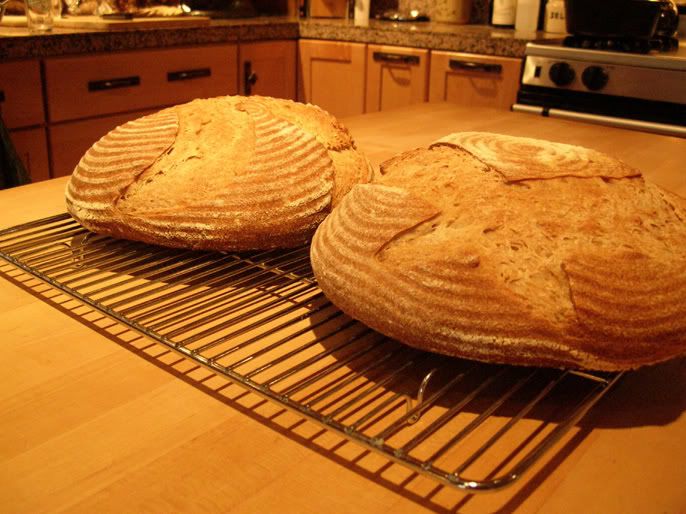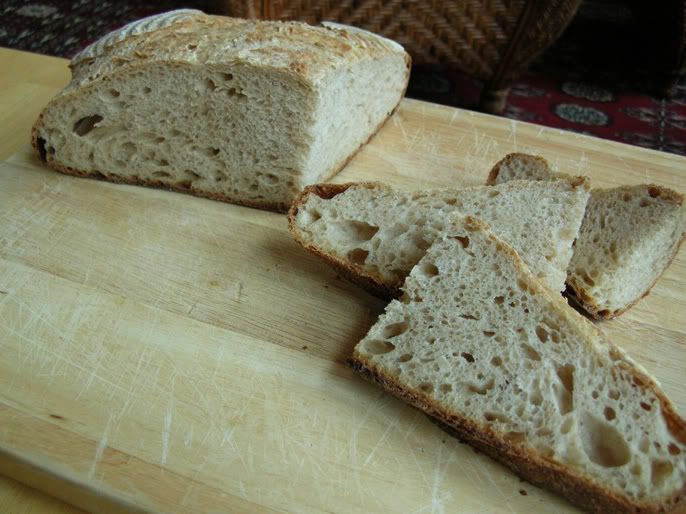
Semolina Filone No. 2
As promised, I made a second Filone today using methods mentioned before, just to make sure I could duplicate the formula. Worked out great. First picture is the whole filone, and the second picture is the filone sliced:



As promised, I made a second Filone today using methods mentioned before, just to make sure I could duplicate the formula. Worked out great. First picture is the whole filone, and the second picture is the filone sliced:



I am not sure how to go about this, but what is the rule or concensus on posting recipes from books, whather we modify them or not?

For about the past 2-3 weeks, it seems that my Thom Leonard boules, which I have made every week since about November, are suddenly coming out overproofed even though I have not changed my technique: as soon as the loaves are slashed on the peel and hit the hot oven stone, they collapse and spread out at the slashes.
I was wondering if it was because my 100% hydration starter is getting very acidic as it is maturing, despite being well fed at either 1:4:4 or 1:2:2 by weight. Do I need to adjust proofing times and temps accordingly with a strong starter? Is it gobbling up the gluten too fast? Seems if I feed my starter more than 1:4:4 it does not get active enough, though, so I don't want to over-dilute it either. Are the population of lbs overpowering the polulation of yeasts?
 To try to adjust, in yesterdays batch, I used a slightly stiffer dough, and lowered the first fermenting time from 4-5 hours down to 3-3.5, before the dough doubled, then proofed for only 2.5 hours down from 3.5-4. I also fermented and proofed at about 75F rather than 85F.
To try to adjust, in yesterdays batch, I used a slightly stiffer dough, and lowered the first fermenting time from 4-5 hours down to 3-3.5, before the dough doubled, then proofed for only 2.5 hours down from 3.5-4. I also fermented and proofed at about 75F rather than 85F.
I got better results but still not as good as I had in the very beginning of my sourgdough baking: the loaves still rose nicely and held their shape a little better in the bannetons but still spread out very wide at slashes when I slashed and baked, but at least this time they got decent oven spring and rose to a better dome than my last 2-3 tries. Notice how much the dough spread out at the slashes - the interior had little structure and was getting gooey and batter-like just before putting in the oven.
I got some holes in the crumb but nothing spectacular, more dense in the center than I like for this recipe:

The only other variable I can think of between the past 2-3 weeks and before, other than the acidity of my starter, is that I am now using King Arthur organic artisan flour rather than the King Arthur regualr AP flour. Perhaps the organic artisan is using a softer wheat and therefore has less gluten? They have about the same protein and ash contents according to the KA website, though.
Any ideas on what is going on? Suggestions?

For those of you who grind your own flour ...where do you buy your grain? I live in the Seattle area and am interested in both local dealers and internet dealers. I don't have a mill yet ...want to make sure it is going to be practical to buy the wheat first ...and I would want White Wheat (not the traditional "Red" wheat) before investing in the mill.
Patrick

This weekend's bread. Best crust ever and great taste:


Made a Semolina Filone this weekend. Crust was best I've ever had and taste was wonderful:


We will be doing some extensive renovations to our kitchen, which is giving us the opportunity to plan it the way we'd like it. My question is: what kind of design/plan would you put into your ideal kitchen in terms of baking? Or, what do you have in your current kitchen that makes it convenient/conducive to baking?
We've already decided we'd like a dual fuel range and a heatproof countertop (not sure whether concrete, granite, marble, etc, though).
All feedback welcome! Thanks in advance.

I posted this somewhere here a long time back, but thought I'd post again to make it easier to find. I'll try to remember to get some photos next time I make them before they get all eaten! I may try to make these into a sourdough recipe like JMonkey did here in order to use up excess starter...I'll report on that when I do, but for now, these just use baking powder.
This is a recipe I developed about 2 years ago that people seem to love. I make it with whole organic spelt flour as I like the nutty taste of spelt - an ancient form of wheat that has very little gluten, so it's not as good for rustic breads but great in quick breads. You can also use whole wheat flour equally well but may need to adjust amounts depending on humidity. I added the whole brown flaxseeds for roughage, texture, and hopefully some health benefits, although the most benefit is derived from raw ground flax.
What I like about this recipe is it does not contain dairy - which I am allergic to (although it does have eggs so it's not vegan). It is also a little less sweet by using dark brown sugar rather than white, and is not too spicy as I omit nutmeg or clove, opting for the combo of cinnamon and ginger instead. I also make this same basic recipe with bananas or frozen blueberries or chopped apple rather than pumpkin and all come out equally great. If you like a sweeter muffin, add more brown sugar. Obviously, this can be made in a loaf pan as well as in muffin tins, but adjust baking time and temp. accordingly:
Spelt Flaxseed Muffins
Ingredients (makes 12 large muffins or 24 small muffins):
Wet:
4 Large Eggs
1 c. Vegetable Oil (Sunflower, Safflower, or Canola)
1 c. Dark Brown Sugar (maple syrup also tastes great as a sub but need a little more)
2 tsp. Vanilla
1 c. Whole Flax Seeds
Fruit of choice:
For Blueberry Muffins: 2 c. frozen or fresh blueberries
For Pumpkin Muffins: 2 c. canned pureed 100% pumpkin
For Banana Muffins: 3-5 overripe bananas, depending on size (I usually freeze them once they get too ripe so I always have some on hand)
For Apple Muffins: 4 apples, cored, peeled, and chopped into small pieces
Dry:
3 c. Whole Spelt Flour (or substitute mixture of 2.5 c. whole wheat and unbleached white flours, if no spelt available. Wheat flours are drier than spelt, so use less or mixture will be too stiff, resulting in dense, heavy, “hockey puck” muffins).
1.5 tbsp. Baking Powder
1 tsp. Salt
2 tsp. Ground Cinnamon
1 tsp. Ground Ginger
Directions:
1) In a large bowl, beat the eggs, then mix in the remaining wet ingredients, then mix in your fruit of choice and the flaxseeds.
2) In a separate bowl, mix together all of the dry ingredients.
3) Pour the dry ingredients into the wet, and stir. If batter comes out too dry, depending on humidity levels, flour type, or fruit size, then add about 1/8 cup of water or fruit juice. Finished batter should be stiff enough to spoon into muffin tins without it dripping all over, but not so stiff that the batter forms peaks.
4) Grease 12 large muffin cups (or 24 small muffin cups) with canola oil-type cooking spray.
5) Divide the batter up into the cups with a ladle or large spoon and rubber spatula.
6) Bake at 350 degrees F for 40-50 minutes for large muffins, or around 30 minutes for small muffins. Tap on top for doneness - they should be firm and crusty, not too soft or mushy.
7) When done, flip muffins out of pans onto cooling rack and let cool.
8) Use within a day or two, or refrigerate in plastic bags for up to 10 days or so. Freeze the rest for up to 6 months. Just reheat in a toaster oven and enjoy!

Does anyone know where to obtain high extraction wheat flour? I've made my own from flour I've milled myself, and it's too much work with the rudimentary tools I have. So far, Google hasn't found me a source. Another question is Does anyone know of a bolting machine or other sifting device for making high extraction flour that is appropriate for home use?
Yet another question is Does adding white flour to whole wheat produce a flour close enough to high extraction flour to make the search for the real thing unnecessary?
Thanks,
Tony